Global Business Management: Case Analysis of the Automotive Sector
VerifiedAdded on 2022/10/10
|8
|1371
|342
Case Study
AI Summary
This case analysis examines the global business management strategies within the automotive industry, specifically focusing on the Chinese market. The study identifies the automotive sector as innovative, analyzing companies like Beijing Automotive Industry Ltd, SAIC Motor, and others. It provides historical context, highlighting China's dominance in automotive production and its evolution. The core of the analysis applies Michael Porter's Five Forces model to assess the competitive landscape, including threats from new entrants, the threat of substitution, bargaining power of buyers and suppliers, and rivalry among existing competitors. The analysis suggests that the Chinese automotive sector is attractive for investors because of its good quality products and customer service. The study underscores the importance of adapting strategies to the specific market conditions within China, emphasizing competitive pricing and innovation to maintain a strong market position. The paper aims to provide insights into the challenges and opportunities for automotive companies expanding their operations in foreign markets.
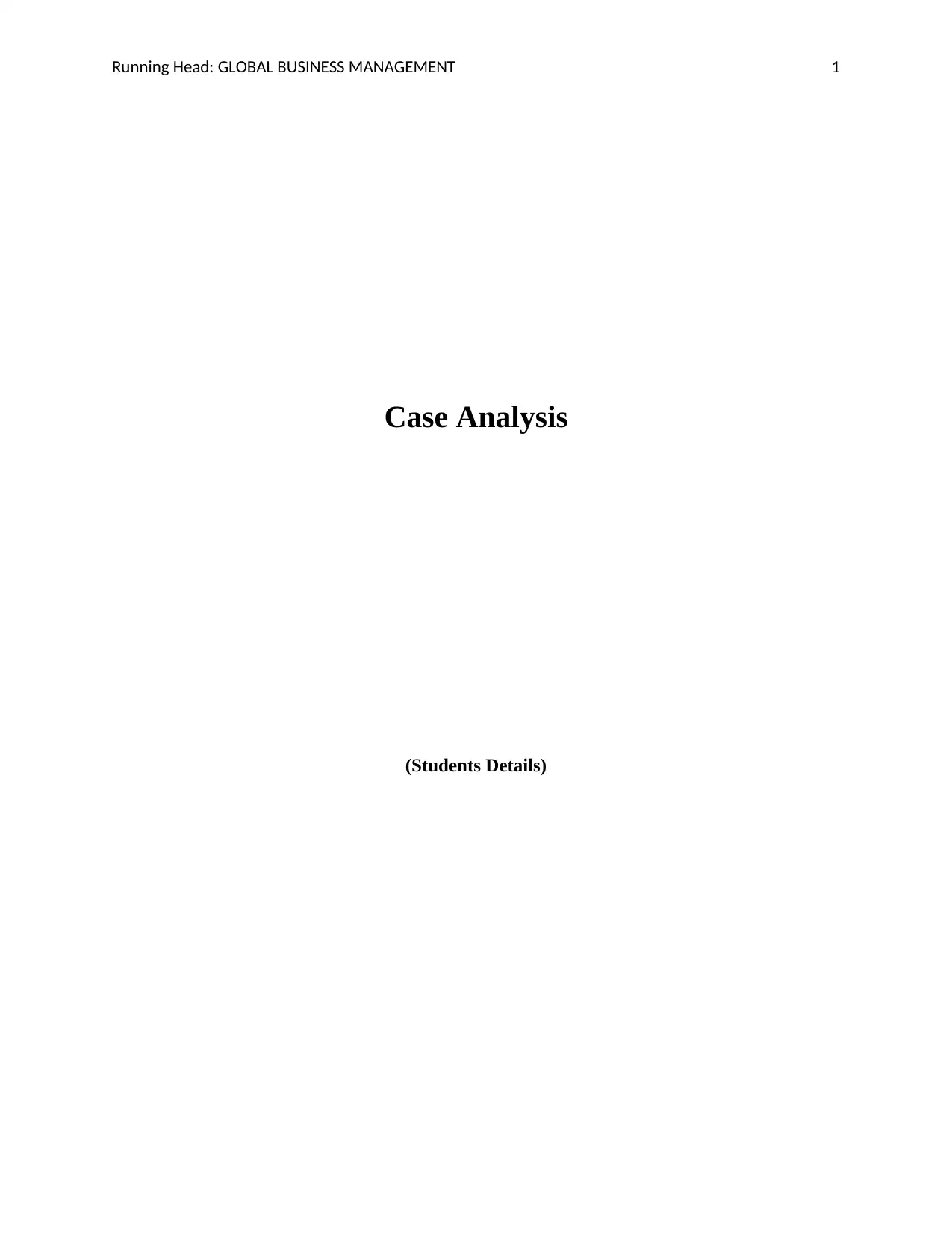
Running Head: GLOBAL BUSINESS MANAGEMENT 1
Case Analysis
(Students Details)
Case Analysis
(Students Details)
Paraphrase This Document
Need a fresh take? Get an instant paraphrase of this document with our AI Paraphraser
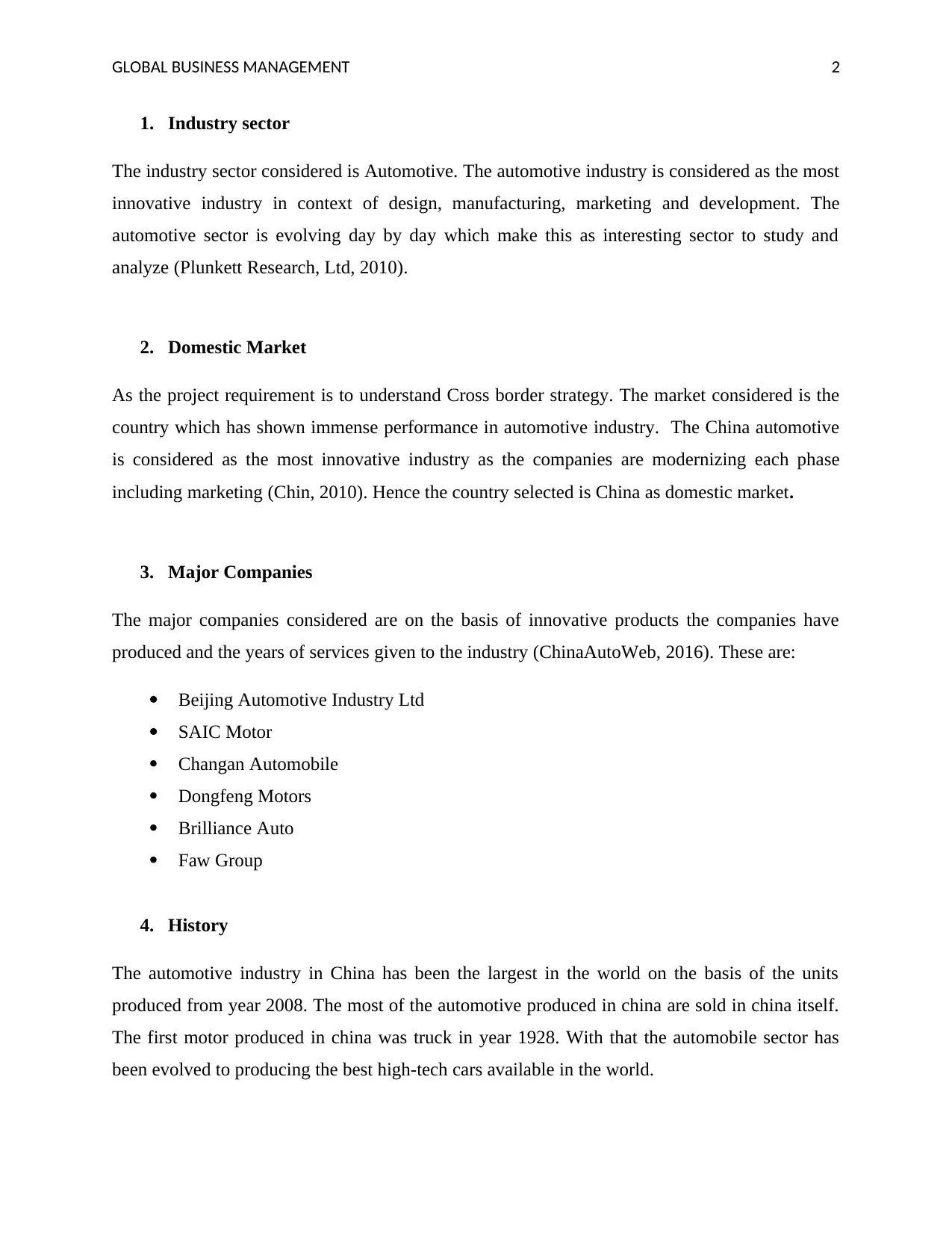
GLOBAL BUSINESS MANAGEMENT 2
1. Industry sector
The industry sector considered is Automotive. The automotive industry is considered as the most
innovative industry in context of design, manufacturing, marketing and development. The
automotive sector is evolving day by day which make this as interesting sector to study and
analyze (Plunkett Research, Ltd, 2010).
2. Domestic Market
As the project requirement is to understand Cross border strategy. The market considered is the
country which has shown immense performance in automotive industry. The China automotive
is considered as the most innovative industry as the companies are modernizing each phase
including marketing (Chin, 2010). Hence the country selected is China as domestic market.
3. Major Companies
The major companies considered are on the basis of innovative products the companies have
produced and the years of services given to the industry (ChinaAutoWeb, 2016). These are:
Beijing Automotive Industry Ltd
SAIC Motor
Changan Automobile
Dongfeng Motors
Brilliance Auto
Faw Group
4. History
The automotive industry in China has been the largest in the world on the basis of the units
produced from year 2008. The most of the automotive produced in china are sold in china itself.
The first motor produced in china was truck in year 1928. With that the automobile sector has
been evolved to producing the best high-tech cars available in the world.
1. Industry sector
The industry sector considered is Automotive. The automotive industry is considered as the most
innovative industry in context of design, manufacturing, marketing and development. The
automotive sector is evolving day by day which make this as interesting sector to study and
analyze (Plunkett Research, Ltd, 2010).
2. Domestic Market
As the project requirement is to understand Cross border strategy. The market considered is the
country which has shown immense performance in automotive industry. The China automotive
is considered as the most innovative industry as the companies are modernizing each phase
including marketing (Chin, 2010). Hence the country selected is China as domestic market.
3. Major Companies
The major companies considered are on the basis of innovative products the companies have
produced and the years of services given to the industry (ChinaAutoWeb, 2016). These are:
Beijing Automotive Industry Ltd
SAIC Motor
Changan Automobile
Dongfeng Motors
Brilliance Auto
Faw Group
4. History
The automotive industry in China has been the largest in the world on the basis of the units
produced from year 2008. The most of the automotive produced in china are sold in china itself.
The first motor produced in china was truck in year 1928. With that the automobile sector has
been evolved to producing the best high-tech cars available in the world.
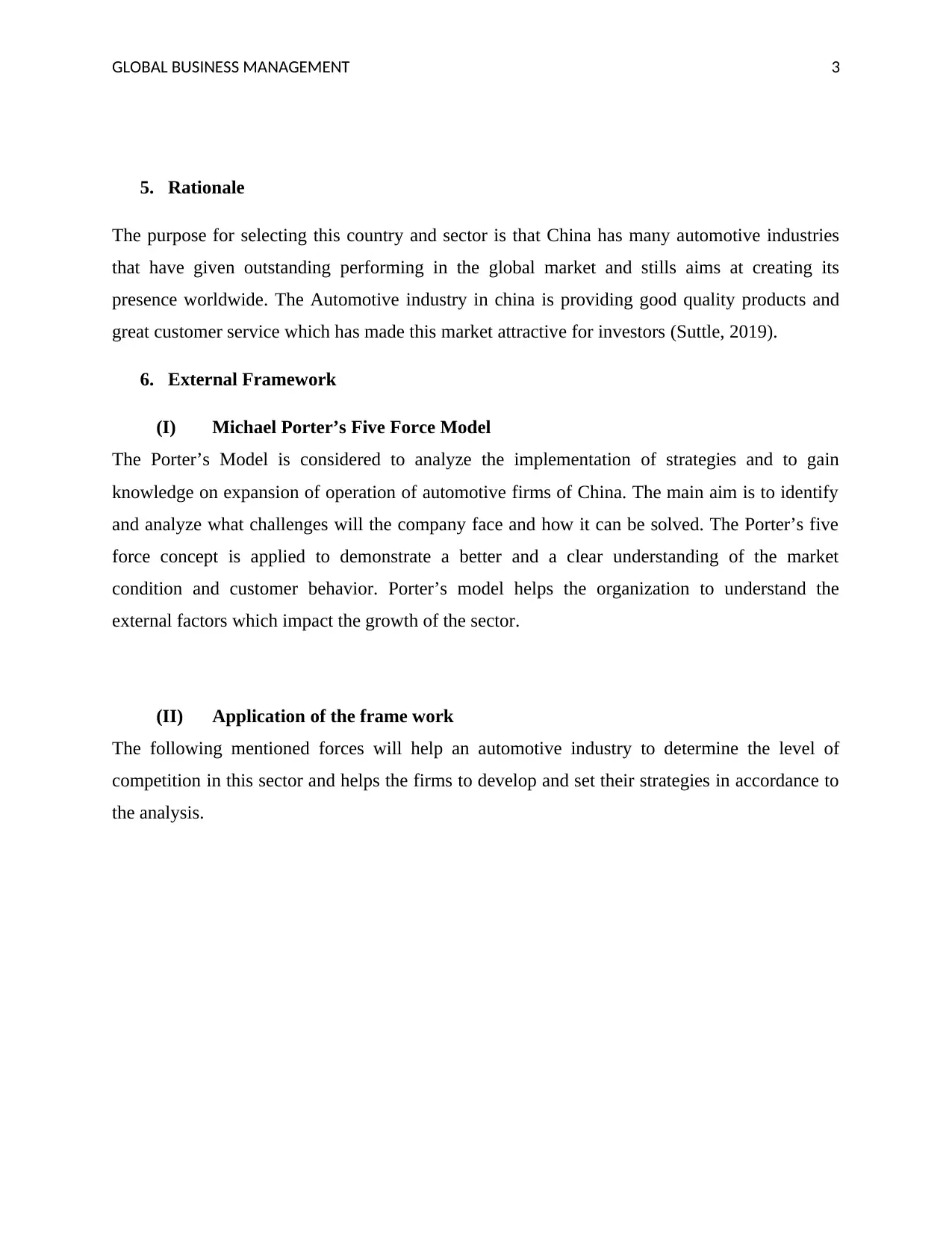
GLOBAL BUSINESS MANAGEMENT 3
5. Rationale
The purpose for selecting this country and sector is that China has many automotive industries
that have given outstanding performing in the global market and stills aims at creating its
presence worldwide. The Automotive industry in china is providing good quality products and
great customer service which has made this market attractive for investors (Suttle, 2019).
6. External Framework
(I) Michael Porter’s Five Force Model
The Porter’s Model is considered to analyze the implementation of strategies and to gain
knowledge on expansion of operation of automotive firms of China. The main aim is to identify
and analyze what challenges will the company face and how it can be solved. The Porter’s five
force concept is applied to demonstrate a better and a clear understanding of the market
condition and customer behavior. Porter’s model helps the organization to understand the
external factors which impact the growth of the sector.
(II) Application of the frame work
The following mentioned forces will help an automotive industry to determine the level of
competition in this sector and helps the firms to develop and set their strategies in accordance to
the analysis.
5. Rationale
The purpose for selecting this country and sector is that China has many automotive industries
that have given outstanding performing in the global market and stills aims at creating its
presence worldwide. The Automotive industry in china is providing good quality products and
great customer service which has made this market attractive for investors (Suttle, 2019).
6. External Framework
(I) Michael Porter’s Five Force Model
The Porter’s Model is considered to analyze the implementation of strategies and to gain
knowledge on expansion of operation of automotive firms of China. The main aim is to identify
and analyze what challenges will the company face and how it can be solved. The Porter’s five
force concept is applied to demonstrate a better and a clear understanding of the market
condition and customer behavior. Porter’s model helps the organization to understand the
external factors which impact the growth of the sector.
(II) Application of the frame work
The following mentioned forces will help an automotive industry to determine the level of
competition in this sector and helps the firms to develop and set their strategies in accordance to
the analysis.
⊘ This is a preview!⊘
Do you want full access?
Subscribe today to unlock all pages.

Trusted by 1+ million students worldwide
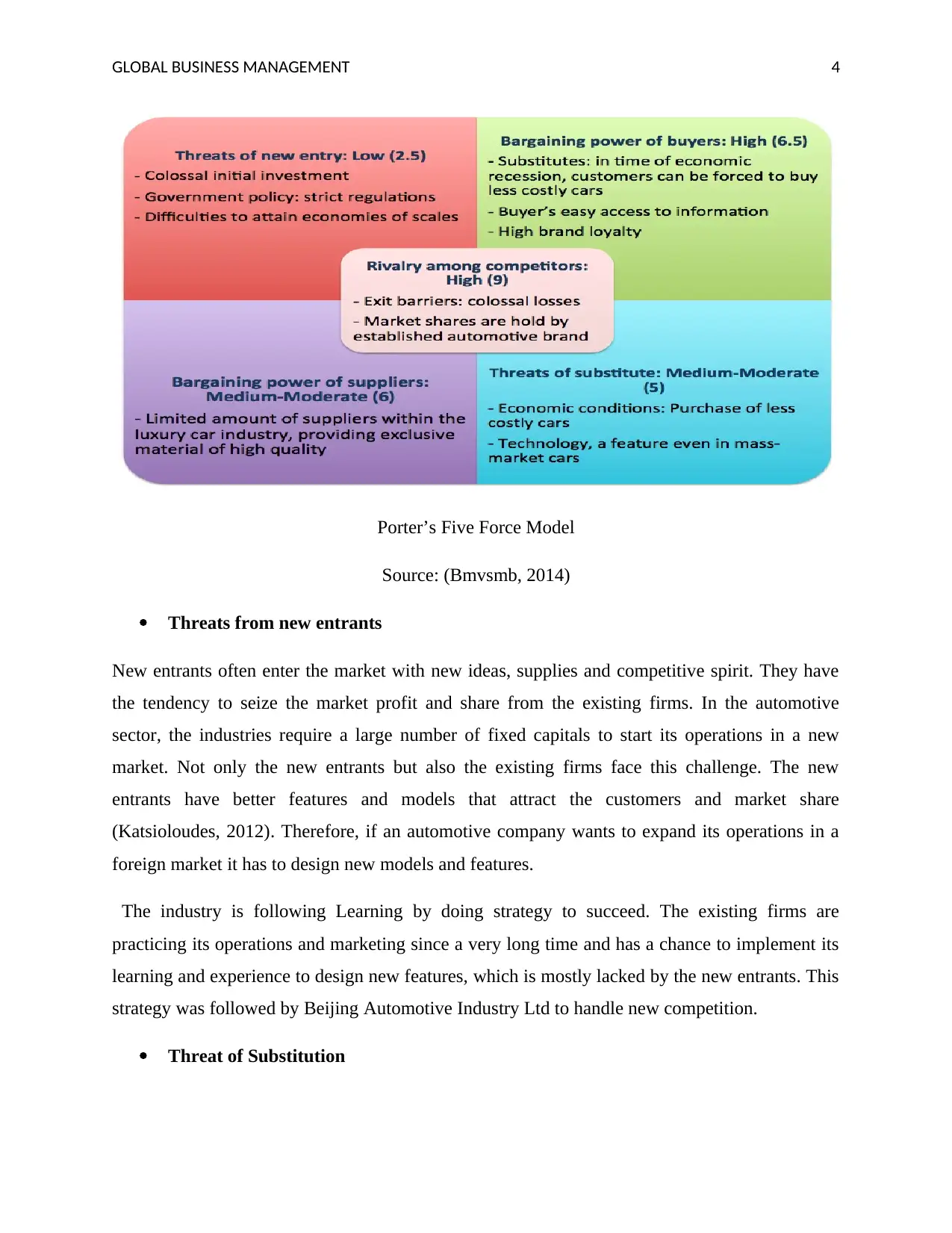
GLOBAL BUSINESS MANAGEMENT 4
Porter’s Five Force Model
Source: (Bmvsmb, 2014)
Threats from new entrants
New entrants often enter the market with new ideas, supplies and competitive spirit. They have
the tendency to seize the market profit and share from the existing firms. In the automotive
sector, the industries require a large number of fixed capitals to start its operations in a new
market. Not only the new entrants but also the existing firms face this challenge. The new
entrants have better features and models that attract the customers and market share
(Katsioloudes, 2012). Therefore, if an automotive company wants to expand its operations in a
foreign market it has to design new models and features.
The industry is following Learning by doing strategy to succeed. The existing firms are
practicing its operations and marketing since a very long time and has a chance to implement its
learning and experience to design new features, which is mostly lacked by the new entrants. This
strategy was followed by Beijing Automotive Industry Ltd to handle new competition.
Threat of Substitution
Porter’s Five Force Model
Source: (Bmvsmb, 2014)
Threats from new entrants
New entrants often enter the market with new ideas, supplies and competitive spirit. They have
the tendency to seize the market profit and share from the existing firms. In the automotive
sector, the industries require a large number of fixed capitals to start its operations in a new
market. Not only the new entrants but also the existing firms face this challenge. The new
entrants have better features and models that attract the customers and market share
(Katsioloudes, 2012). Therefore, if an automotive company wants to expand its operations in a
foreign market it has to design new models and features.
The industry is following Learning by doing strategy to succeed. The existing firms are
practicing its operations and marketing since a very long time and has a chance to implement its
learning and experience to design new features, which is mostly lacked by the new entrants. This
strategy was followed by Beijing Automotive Industry Ltd to handle new competition.
Threat of Substitution
Paraphrase This Document
Need a fresh take? Get an instant paraphrase of this document with our AI Paraphraser
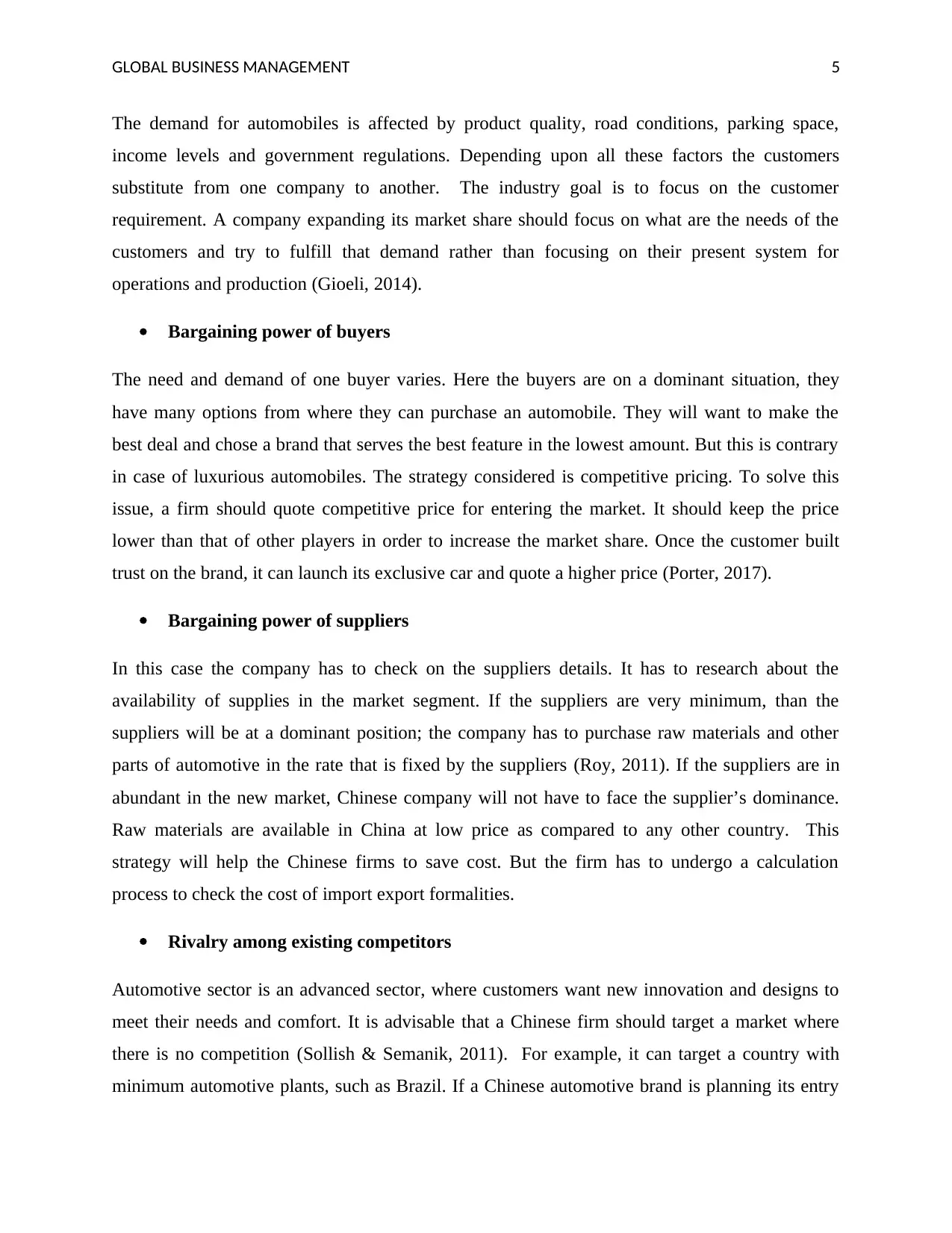
GLOBAL BUSINESS MANAGEMENT 5
The demand for automobiles is affected by product quality, road conditions, parking space,
income levels and government regulations. Depending upon all these factors the customers
substitute from one company to another. The industry goal is to focus on the customer
requirement. A company expanding its market share should focus on what are the needs of the
customers and try to fulfill that demand rather than focusing on their present system for
operations and production (Gioeli, 2014).
Bargaining power of buyers
The need and demand of one buyer varies. Here the buyers are on a dominant situation, they
have many options from where they can purchase an automobile. They will want to make the
best deal and chose a brand that serves the best feature in the lowest amount. But this is contrary
in case of luxurious automobiles. The strategy considered is competitive pricing. To solve this
issue, a firm should quote competitive price for entering the market. It should keep the price
lower than that of other players in order to increase the market share. Once the customer built
trust on the brand, it can launch its exclusive car and quote a higher price (Porter, 2017).
Bargaining power of suppliers
In this case the company has to check on the suppliers details. It has to research about the
availability of supplies in the market segment. If the suppliers are very minimum, than the
suppliers will be at a dominant position; the company has to purchase raw materials and other
parts of automotive in the rate that is fixed by the suppliers (Roy, 2011). If the suppliers are in
abundant in the new market, Chinese company will not have to face the supplier’s dominance.
Raw materials are available in China at low price as compared to any other country. This
strategy will help the Chinese firms to save cost. But the firm has to undergo a calculation
process to check the cost of import export formalities.
Rivalry among existing competitors
Automotive sector is an advanced sector, where customers want new innovation and designs to
meet their needs and comfort. It is advisable that a Chinese firm should target a market where
there is no competition (Sollish & Semanik, 2011). For example, it can target a country with
minimum automotive plants, such as Brazil. If a Chinese automotive brand is planning its entry
The demand for automobiles is affected by product quality, road conditions, parking space,
income levels and government regulations. Depending upon all these factors the customers
substitute from one company to another. The industry goal is to focus on the customer
requirement. A company expanding its market share should focus on what are the needs of the
customers and try to fulfill that demand rather than focusing on their present system for
operations and production (Gioeli, 2014).
Bargaining power of buyers
The need and demand of one buyer varies. Here the buyers are on a dominant situation, they
have many options from where they can purchase an automobile. They will want to make the
best deal and chose a brand that serves the best feature in the lowest amount. But this is contrary
in case of luxurious automobiles. The strategy considered is competitive pricing. To solve this
issue, a firm should quote competitive price for entering the market. It should keep the price
lower than that of other players in order to increase the market share. Once the customer built
trust on the brand, it can launch its exclusive car and quote a higher price (Porter, 2017).
Bargaining power of suppliers
In this case the company has to check on the suppliers details. It has to research about the
availability of supplies in the market segment. If the suppliers are very minimum, than the
suppliers will be at a dominant position; the company has to purchase raw materials and other
parts of automotive in the rate that is fixed by the suppliers (Roy, 2011). If the suppliers are in
abundant in the new market, Chinese company will not have to face the supplier’s dominance.
Raw materials are available in China at low price as compared to any other country. This
strategy will help the Chinese firms to save cost. But the firm has to undergo a calculation
process to check the cost of import export formalities.
Rivalry among existing competitors
Automotive sector is an advanced sector, where customers want new innovation and designs to
meet their needs and comfort. It is advisable that a Chinese firm should target a market where
there is no competition (Sollish & Semanik, 2011). For example, it can target a country with
minimum automotive plants, such as Brazil. If a Chinese automotive brand is planning its entry
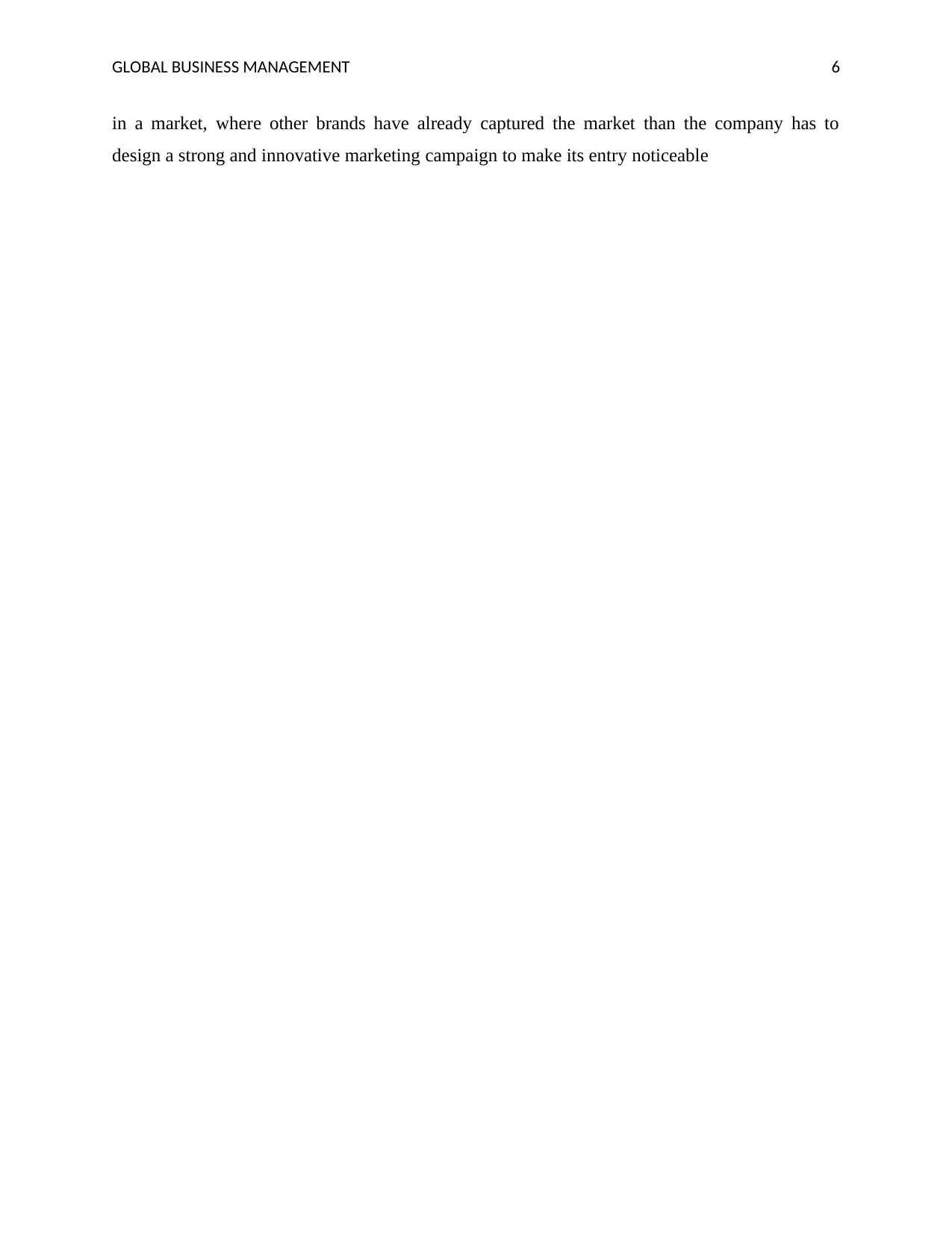
GLOBAL BUSINESS MANAGEMENT 6
in a market, where other brands have already captured the market than the company has to
design a strong and innovative marketing campaign to make its entry noticeable
in a market, where other brands have already captured the market than the company has to
design a strong and innovative marketing campaign to make its entry noticeable
⊘ This is a preview!⊘
Do you want full access?
Subscribe today to unlock all pages.

Trusted by 1+ million students worldwide
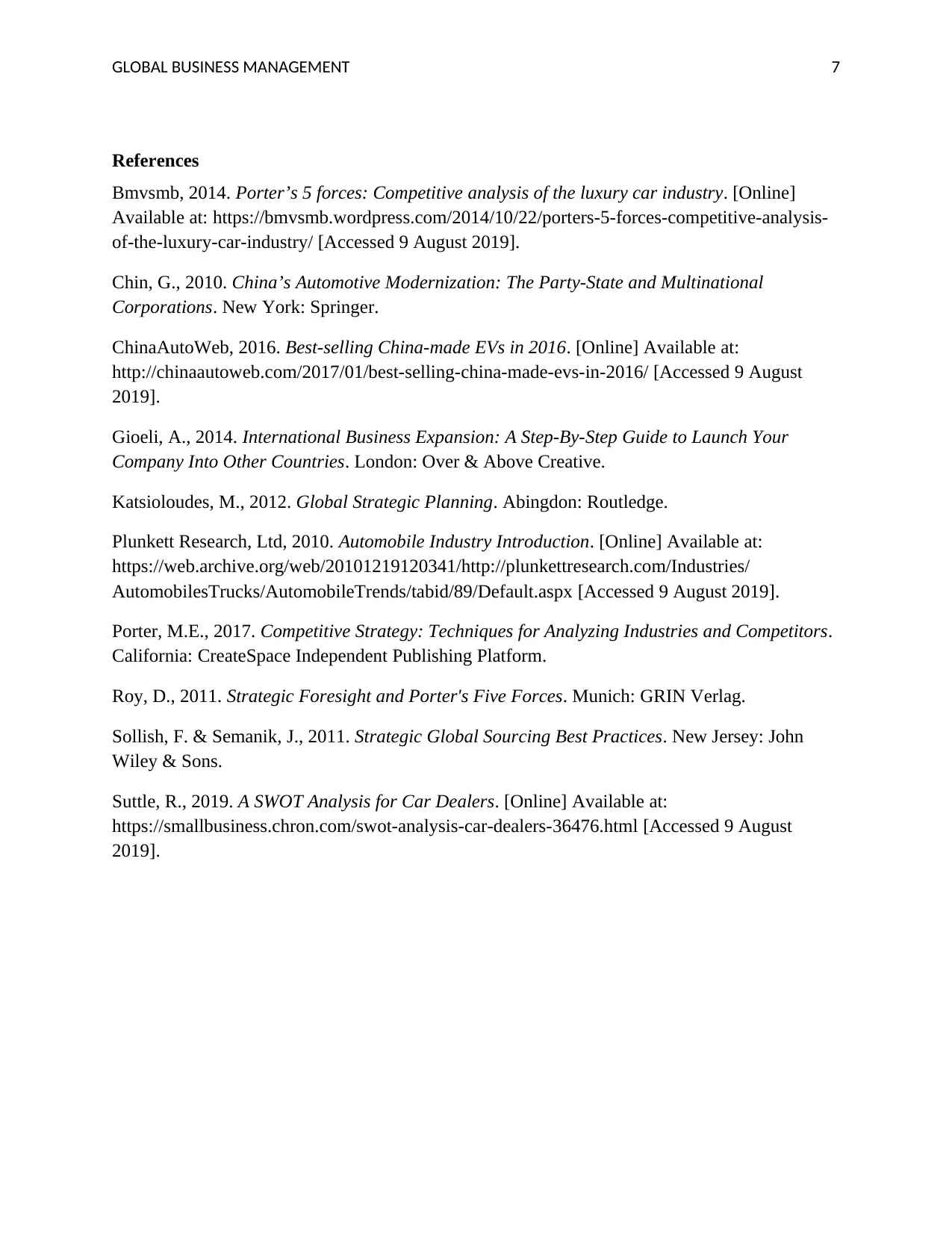
GLOBAL BUSINESS MANAGEMENT 7
References
Bmvsmb, 2014. Porter’s 5 forces: Competitive analysis of the luxury car industry. [Online]
Available at: https://bmvsmb.wordpress.com/2014/10/22/porters-5-forces-competitive-analysis-
of-the-luxury-car-industry/ [Accessed 9 August 2019].
Chin, G., 2010. China’s Automotive Modernization: The Party-State and Multinational
Corporations. New York: Springer.
ChinaAutoWeb, 2016. Best-selling China-made EVs in 2016. [Online] Available at:
http://chinaautoweb.com/2017/01/best-selling-china-made-evs-in-2016/ [Accessed 9 August
2019].
Gioeli, A., 2014. International Business Expansion: A Step-By-Step Guide to Launch Your
Company Into Other Countries. London: Over & Above Creative.
Katsioloudes, M., 2012. Global Strategic Planning. Abingdon: Routledge.
Plunkett Research, Ltd, 2010. Automobile Industry Introduction. [Online] Available at:
https://web.archive.org/web/20101219120341/http://plunkettresearch.com/Industries/
AutomobilesTrucks/AutomobileTrends/tabid/89/Default.aspx [Accessed 9 August 2019].
Porter, M.E., 2017. Competitive Strategy: Techniques for Analyzing Industries and Competitors.
California: CreateSpace Independent Publishing Platform.
Roy, D., 2011. Strategic Foresight and Porter's Five Forces. Munich: GRIN Verlag.
Sollish, F. & Semanik, J., 2011. Strategic Global Sourcing Best Practices. New Jersey: John
Wiley & Sons.
Suttle, R., 2019. A SWOT Analysis for Car Dealers. [Online] Available at:
https://smallbusiness.chron.com/swot-analysis-car-dealers-36476.html [Accessed 9 August
2019].
References
Bmvsmb, 2014. Porter’s 5 forces: Competitive analysis of the luxury car industry. [Online]
Available at: https://bmvsmb.wordpress.com/2014/10/22/porters-5-forces-competitive-analysis-
of-the-luxury-car-industry/ [Accessed 9 August 2019].
Chin, G., 2010. China’s Automotive Modernization: The Party-State and Multinational
Corporations. New York: Springer.
ChinaAutoWeb, 2016. Best-selling China-made EVs in 2016. [Online] Available at:
http://chinaautoweb.com/2017/01/best-selling-china-made-evs-in-2016/ [Accessed 9 August
2019].
Gioeli, A., 2014. International Business Expansion: A Step-By-Step Guide to Launch Your
Company Into Other Countries. London: Over & Above Creative.
Katsioloudes, M., 2012. Global Strategic Planning. Abingdon: Routledge.
Plunkett Research, Ltd, 2010. Automobile Industry Introduction. [Online] Available at:
https://web.archive.org/web/20101219120341/http://plunkettresearch.com/Industries/
AutomobilesTrucks/AutomobileTrends/tabid/89/Default.aspx [Accessed 9 August 2019].
Porter, M.E., 2017. Competitive Strategy: Techniques for Analyzing Industries and Competitors.
California: CreateSpace Independent Publishing Platform.
Roy, D., 2011. Strategic Foresight and Porter's Five Forces. Munich: GRIN Verlag.
Sollish, F. & Semanik, J., 2011. Strategic Global Sourcing Best Practices. New Jersey: John
Wiley & Sons.
Suttle, R., 2019. A SWOT Analysis for Car Dealers. [Online] Available at:
https://smallbusiness.chron.com/swot-analysis-car-dealers-36476.html [Accessed 9 August
2019].
Paraphrase This Document
Need a fresh take? Get an instant paraphrase of this document with our AI Paraphraser
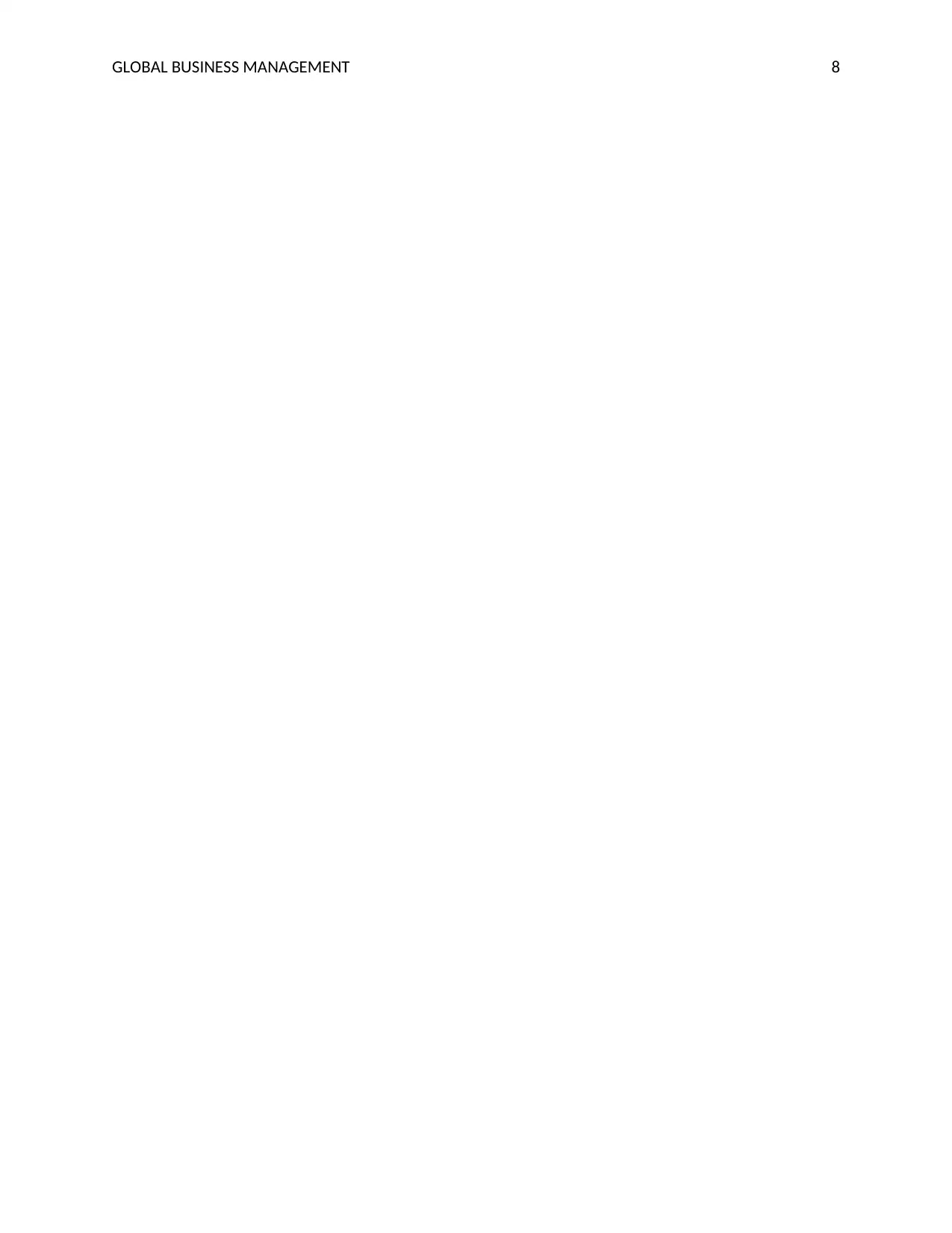
GLOBAL BUSINESS MANAGEMENT 8
1 out of 8
Related Documents
Your All-in-One AI-Powered Toolkit for Academic Success.
+13062052269
info@desklib.com
Available 24*7 on WhatsApp / Email
![[object Object]](/_next/static/media/star-bottom.7253800d.svg)
Unlock your academic potential
Copyright © 2020–2025 A2Z Services. All Rights Reserved. Developed and managed by ZUCOL.





